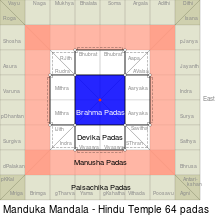Vaastu Shastra - Mandala types and properties:
Mandala types and properties

The 8x8 (64) grid Manduka Vastu Purusha Mandala layout for Hindu Temples. It is one of 32 Vastu Purusha Mandala grid patterns described in Vastu sastras. In this grid structure of symmetry, each concentric layer has significance.[9]
The central area in all mandala is theBrahmasthana. Mandala "circle-circumference" or "completion", is a concentric diagram having spiritual and ritual significance in both Hinduism and Buddhism. The space occupied by it varies in differentmandala – in Pitha (9) and Upapitha (25) it occupies one square module, in Mahaapitha(16), Ugrapitha (36) and Manduka (64), four square modules and in Sthandila (49) andParamasaayika (81), nine square modules.[41]The Pitha is an amplified Prithvimandala in which, according to some texts, the central space is occupied by earth. The Sthandila mandala is used in a concentric manner.[41]
The most important mandala is the Manduka/ Chandita Mandala of 64 squares and the Paramasaayika Mandala of 81 squares. The normal position of the Vastu Purusha (head in the northeast, legs in the southwest) is as depicted in the Paramasaayika Mandala. However, in the Manduka Mandala the Vastu Purusha is depicted with the head facing east and the feet facing west.[citation needed]
It is believed that every piece of a land or a building has a soul of its own and that soul is known as Vastu Purusha.[42]
A site of any shape can be divided using the Pada Vinyasa. Sites are known by the number of squares. They range from 1x1 to 32x32 (1024) square sites. Examples of mandalas with the corresponding names of sites include:[9]
- Sakala (1 square) corresponds to Eka-pada(single divided site)
- Pechaka (4 squares) corresponds to Dwi-pada (two divided site)
- Pitha (9 squares) corresponds to Tri-pada(three divided site)
- Mahaapitha (16 squares) corresponds toChatush-pada (four divided site)
- Upapitha (25 squares) corresponds toPancha-pada (five divided site)
- Ugrapitha (36 squares) corresponds toShashtha-pada (six divided site)
- Sthandila (49 squares) corresponds tosapta-pada (seven divided site)
- Manduka/ Chandita (64 square) corresponds to Ashta-pada (eight divided site))
- Paramasaayika (81 squares)
- Paramasaayika (81 squares) corresponds toNava-pada (nine divided site)
- Aasana (100 squares) corresponds to Dasa-pada (ten divided site)
No comments:
Post a Comment